It seems like most people develop an interest in orchids because of their flowers. While I do appreciate their flowers...I became interested in orchids because
they grow on trees. Anybody else in the same boat?
Given that the orchid family has more species of
epiphytes than any other plant family...orchids are by far my favorite family. I have way more orchids than any other family...but I also have a crazy collection of epiphytes in other families. Not only that, but I also grow a ton of non-epiphytes on trees. For example, with a decent amount of moss, numerous species of drought tolerant Plectranthus make excellent epiphytes.
The point I'm trying to make is...when I say that the following plant is the BEST orchid companion...I'd like to impress on you that my sample size is beyond substantial. I've compared this plant to a gazillion other orchid companions and no other plant even comes close.
Don't want the suspense to do anybody in...so let me introduce you to the BEST orchid companion...
Here's a photo of the flower...
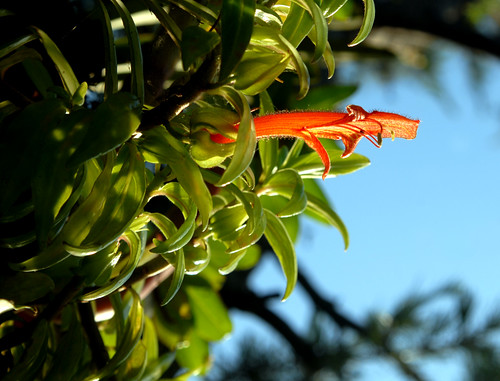 Columnea
Columnea by
epiphyte78, on Flickr
And here's a photo I took earlier in the year of the plant growing and blooming on my tree...
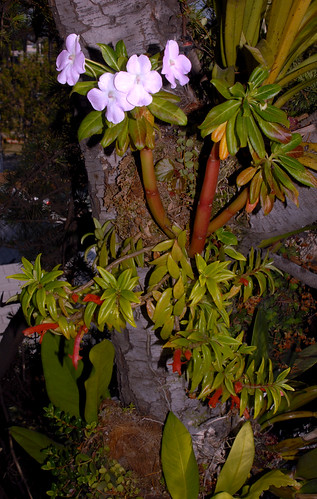 Impatiens sodenii and Columnea
Impatiens sodenii and Columnea by
epiphyte78, on Flickr
Unfortunately, it's kind of an awkward introduction because I don't know the plant's full name. It's definitely a Columnea...but I don't know which species. Columneas are a genus of
epiphytic Gesneriads that are distributed throughout tropical America.
A couple years ago my 99 year old plant mentor/sensei, Elmer Lorenz, gave me a cutting from his plant that he has been growing outdoors year around in Eagle Rock, Southern California. He's long since lost the label but told me that he had received it as a Nematanthus...which is another genus in the Gesneriad family. I'm hardly an expert on Gesneriads but I was pretty sure that it was a Columnea...which I was able to verify on another forum. The closest match I've run across is Columnea crassifolia.
After my friend gave me the cutting...I split it into two divisions (don't keep all your eggs in one basket!!!). One division I placed in a pot with some bark/perlite. The other division I mounted on top of a decent pad of New Zealand Sphagnum that I attached nearly three stories high up on my Cedar tree. I really wasn't expecting the mounted plant to do much because the top of my tree is really exposed to sun and hot dry winds. So it dries out really fast and sometimes I don't get a chance to water.
Shortly after I mounted the Columnea, I was pleasantly surprised when it started putting out quite a bit of new growth. It even managed to bloom before winter. This year it put out an impressive amount of growth and it started to bloom around April. Amazingly enough...it's September and it's still blooming!
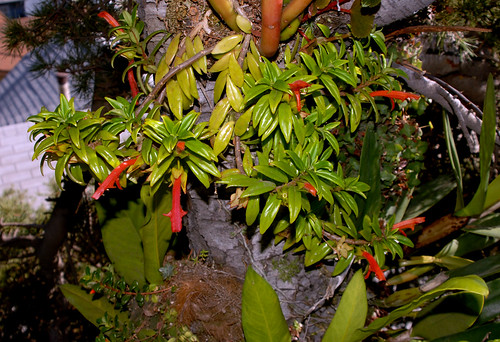 The Best Orchid Companion
The Best Orchid Companion by
epiphyte78, on Flickr
Try as I might, I can't think of any other epiphyte I grow that even comes close to blooming for half the year.
Ok, so here's an overview of why this Columnea is the BEST orchid companion...
- Good strong grower even when mounted
- No problem going bone dry between waterings
- No problem with nearly full sun (maybe even full sun?)
- No problem down to 32F (how low can it go?)
- Nice blooms for at least half the year
- Pretty fleshy leaves and succulent stems
- The tops of the leaves are see through (fenestration)
- Grows easy from seeds/cuttings
Columnea 'Elmer Lorenz' is so cool that every orchid enthusiast should really grow it. With that in mind...I have over 200 seeds to share!
So here's the deal. If you like my favorite cause on facebook (
tax choice), then I'll give you one seed of the BEST orchid companion. Just message me on facebook (tax choice admin) so I can confirm that you liked the page and I'll give you the address where you can send a self-addressed and stamped envelope to. The seeds are pretty small so regular postage should suffice.
In order to sweeten the deal...I'll throw in one seed from each of the following genera (subject to availability)...
Rhipsalis - hanging epiphytic cactus distributed throughout the Americas. Insignificant spines and flowers. A mix of a few different species.
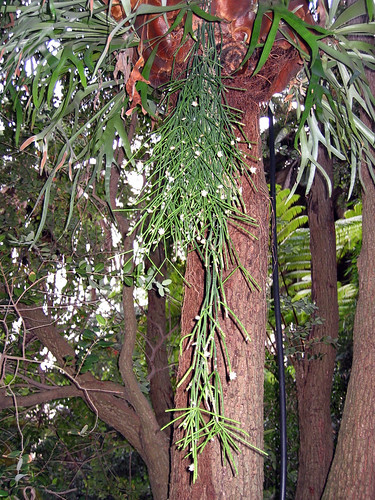 Rhipsalis Growing with Platycerium
Rhipsalis Growing with Platycerium by
epiphyte78, on Flickr
Codonanthe - hanging epiphytic Gesneriad also distributed throughout the Americas. Contains a mix of a few different species.
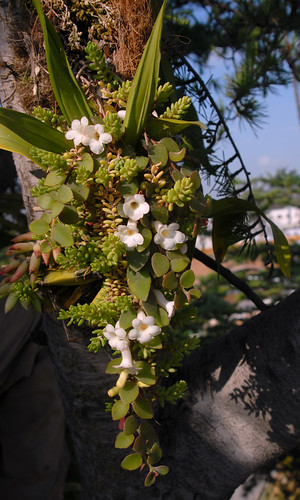 Codonanthe vs Sedum
Codonanthe vs Sedum by
epiphyte78, on Flickr
Aeschynanthus sp - hanging epiphytic Gesneriad but from tropical Asia. The nicest flowers of any Aeschynanthus I've seen. Can't vouch for its tolerance.
This isn't the same species...but thought I'd share this photo of Aeschynanthus evrardii blooming on my tree...
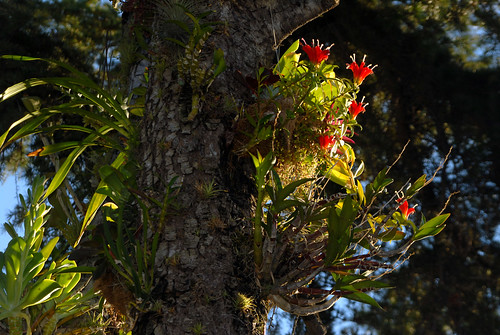 Aeschynanthus Growing Epiphytically
Aeschynanthus Growing Epiphytically by
epiphyte78, on Flickr
Neoregelia bahiana - bromeliad from Brazil. Only have enough for the first 100 people.
My friend in Brazil took this photo...
 Neoregelia bahiana
Neoregelia bahiana by
barbatum, on Flickr
Anthurium scandens - small climbing/hanging Aroid widely spread throughout the Americas. Not very showy "flowers"...but the berries are ornamental. It's my favorite Anthurium because even in relatively dry conditions...it will make really nice aerial roots that look very much like orchid roots. Only have enough seeds for the first 50 people.
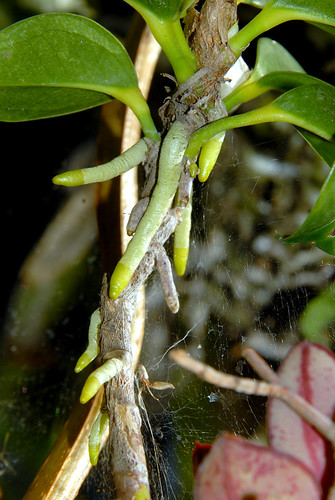 Anthurium scandens
Anthurium scandens by
epiphyte78, on Flickr
Kalanchoes - hanging epiphytic species mainly from Madagascar. Having a bit of difficulty separating the tiny seeds from the chaff...so only have enough for the first 10 people. And I can't even say for certain whether any seeds will be included!
 Kalanchoe uniflora Growing Epiphytically
Kalanchoe uniflora Growing Epiphytically by
epiphyte78, on Flickr
Just to be clear, I'm only giving one seed per genus. This means that the first 10 people will get a total of 7 seeds...the next 40 people will get a total of 6 seeds...the next 50 people will get a total of 5 seeds and everybody else should get a total of 4 seeds.
Sowing the seeds is pretty easy. Here's my technique...
- Soak the seeds in water for a couple days
- Grab a small, clear, plastic water bottle and cut the top off
- Remove the label and cut a few drainage holes
- Fill the bottle almost half way with medium bark and perlite
- Add a half inch or so layer of New Zealand Sphagnum on top
- Run water through the bottle to completely soak the medium
- Sow the seed(s) on top
- Place the bottle in a ziploc bag
- Seal the bag and place it in bright light
As long as you avoid placing the bag in direct sun and give the seeds sufficient warmth, then they should sprout within a couple or so days. The Aeschynanthus is really the only slow poke. All the seedlings will benefit from a very weak soluble orchid fertilizer. Once the seedlings are large enough...then over the course of a week or so you can open the bag to gradually acclimate them to less humid conditions. Culture wise give them excellent drainage, bright light and intermediate temps.
With only one seed per genus, you don't have many chances for success. So if only some of your seeds successfully germinate...then you might reply to this thread in order to find other members to trade cuttings and future seeds with. Except for the Bromeliad, they can all be easily grown from cuttings.
For those of you that prefer instant gratification...I highly recommend
Kartuz Greenhouses. I've received quite a few of these plants/seeds from my friend Michael and shared a few others with him as well.
While instant gratification is kinda nice...it would be impossible for me to overemphasize the value of growing epiphytes from seed. The world would be a far better place if every tree had at least one epiphyte attached to it. The more drought/cold tolerant an epiphyte is...the more trees that it can be attached to. If we grow epiphytes from seed then we can either intentionally or unintentionally select for individuals that might be exceptionally drought/cold tolerant. Therefore, the more epiphytes we grow from seed...the more drought/cold tolerant they'll become...and the more trees that we'll be able to attach a wider variety of epiphytes to.
Does anybody know of any other orchid companions that might give Columnea 'Elmer Lorenz' a run for its money? If so, then I'd definitely love to hear about them! Plus, I'd also be interested in learning about any efficient methods for processing seeds.
Let me know if you have any questions! Please keep us up to date on your seedlings' progress!







































 Linear Mode
Linear Mode


